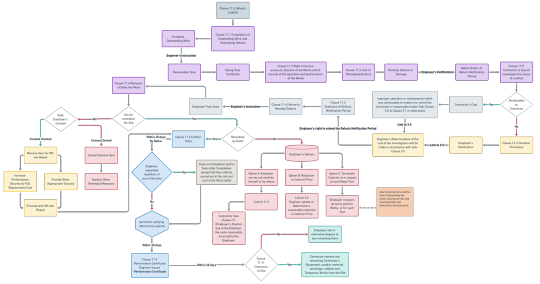#riskallocation
Explore tagged Tumblr posts
Text
Flowchart Explaining CLAUSE 11.0 DEFECTS LIABILITY [FIDIC Yellow Book 1999]

Detailed Explanation: Clause 11.1: Completion of Outstanding Work and Remedying Defects - This is the starting point, where the Contractor is obligated to complete any outstanding work and remedy defects as per the Engineer's instructions. The Contractor must complete any work outstanding on the date stated in a Taking-Over Certificate within a reasonable time as instructed by the Engineer. Additionally, the Contractor must execute all work required to remedy defects or damage as may be notified by the Employer on or before the expiry date of the Defects Notification Period. Defect Appears or Damage Occurs - This is an event that triggers the need for remedial action. The Employer notifies the Contractor of the defect or damage. Clause 11.2: Cost of Remedying Defec - This clause specifies who bears the cost of remedying the defects. If the defect is attributable to the Contractor, they bear the cost. Otherwise, Sub-Clause 13.3 (Variation Procedure) applies. - This clause specifies who bears the cost of remedying the defects. The work shall be executed at the risk and cost of the Contractor if it is attributable to: - The design of the Works, except for parts for which the Employer is responsible. - Plant, Materials, or workmanship not being in accordance with the Contract. - Improper operation or maintenance attributable to the Contractor. - Failure by the Contractor to comply with any other obligation. - If the defect is not attributable to the Contractor, they will be notified promptly, and Sub-Clause 13.3 (Variation Procedure) applies. Clause 11.8: Contractor to Search - If required by the Engineer, the Contractor must search for the cause of the defect. This is to determine if the defect is attributable to the Contractor or not. Clause 13.3: Variation Procedure - If the defect is not attributable to the Contractor, this clause is invoked to handle variations in the contract. Employer's Notification - The Employer notifies the Contractor if the defect is not attributable to them. Engineer's Determination (Clause 3 - The Engineer makes a fair determination in accordance with the Contract, which also decides the cost of the investigation. Clause 11.3: Extension of Defects Notification Period - The Employer has the right to extend the Defects Notification Period under certain conditions. - The Employer is entitled to an extension of the Defects Notification Period if the Works, Section, or a major item of Plant cannot be used for their intended purposes due to a defect or damage. This extension is subject to Sub-Clause 2.5 and cannot exceed two years. If delivery and/or erection of Plant and/or Materials was suspended under specific clauses, the Contractor's obligations do not apply to defects or damage occurring more than two years after the original Defects Notification Period would have expired. Employer Fixes Date - If the Contractor fails to remedy the defect within a reasonable time, the Employer may fix a date by which the defect must be remedied. Clause 11.5: Removal of Defective Work - If the defect or damage cannot be remedied expeditiously on the Site and the Employer gives consent, the Contractor may remove such items of Plant as are defective or damaged for the purposes of repair. This consent may require the Contractor to increase the amount of the Performance Security by the full replacement cost of these items, or to provide other appropriate security. Clause 11. - If the work of remedying any defect or damage may affect the performance of the Works, the Engineer may require the repetition of any of the tests described in the Contract, including Tests on Completion and/or Tests after Completion. This requirement must be made by notice within 28 days after the defect or damage is remedied. These tests shall be carried out at the risk and cost of the Party liable under Sub-Clause 11.2 for the cost of the remedial work. Clause 11.4: Failure to Remedy Defects - If the Contractor fails to remedy the defects by the notified date, the Employer has several options: - Carry out the work themselves at the Contractor's cost. - Reduce the Contract Price in accordance with Sub-Clause 3.5. - Terminate the Contract if the defect deprives the Employer of substantially the whole benefit of the Works. Clause 11.9 - The Engineer issues the Performance Certificate, stating the date on which the Contractor completed his obligations. This certificate is deemed to constitute acceptance of the Works. Clause 11.10: Unfulfilled Obligations - Each Party remains liable for any unperformed obligation even after the Performance Certificate has been issued. Clause 11.11: - The Contractor must remove any remaining items from the Site upon receiving the Performance Certificate. The Employer may sell or dispose of any remaining items if not removed within 28 days. Notes: - The Contractor must complete any work that is outstanding on the date stated in a Taking-Over Certificate and execute all work required to remedy defects or damage as notified by the Employer. - Includes reasons like design issues, non-compliance with the contract, improper operation, or failure to comply with other obligations. - The extension is subject to conditions like the Works or Section not being usable for their intended purpose due to defects or damages. - The Employer's consent may require the Contractor to increase the amount of the Performance Security by the full replacement cost of these items. - These tests are carried out at the risk and cost of the Party liable for the cost of the remedial work. - Options include carrying out the work themselves, reducing the Contract Price, or terminating the Contract. - The Performance Certificate is issued within 28 days after the latest of the expiry dates of the Defects Notification Periods or as soon thereafter as the Contractor has completed and tested all the Works. - For determining unperformed obligations, the Contract is deemed to remain in force. - The Employer is entitled to be paid the costs incurred in connection with the sale or disposal and restoring the Site. Any balance of the moneys from the sale shall be paid to the Contractor. Read the full article
#CLAUSE11#CostImpact#DEFECTSLIABILITY#FIDIC#FIDICYellowBook1999#ProjectManagement#RiskAllocation#TimeExtension
1 note
·
View note
Text
Global Market: Wall Street's Recovery Falters; NASDAQ Underperforms Down 1%
1/8 Big news on Wall Street: The global market's recovery hits a snag as the NASDAQ underperforms, down 1%. Investors are keeping a close eye on the latest trends. 📉💼 #GlobalMarketUpdate #NASDAQ #Investing101 2/8 Despite recent gains, the NASDAQ's slip is a surprising turn of events. Tech stocks, which have been a cornerstone of the market's recovery, are now facing renewed pressure. What might be causing this sudden shift? 🤔💻 #TechStocks #MarketTrends 3/8 One factor at play is the concern over rising inflation, prompting fears of higher interest rates. This is causing investors to reassess the valuations of high-growth tech companies, leading to a dampened outlook for the NASDAQ. 💰📈 #Inflation #InterestRates 4/8 Additionally, global economic uncertainties and geopolitical tensions are contributing to the fluctuating market sentiment. These external factors are adding volatility to the already delicate balance of market dynamics. 🌍📊 #EconomicUncertainty #Geopolitics 5/8 The situation calls for a closer examination of portfolio diversification and risk management strategies. With the market exhibiting signs of vulnerability, prudent risk allocation becomes increasingly vital for investors. 📊💡 #PortfolioManagement #RiskAllocation 6/8 As the market landscape continues to evolve, adaptability and informed decision-making will be crucial for navigating these uncertain times. Investors are advised to stay informed, stay vigilant, and consult with financial professionals as needed. 📈📚 #FinancialAdvisory 7/8 It's important to keep an eye on developing trends and news in the coming days to gauge the market's trajectory. Stay tuned for further updates and expert insights as we navigate through this challenging phase in the global market. 💼🔍 #MarketInsights #StayInformed 8/8 TL;DR: NASDAQ underperforms, facing pressure from inflation concerns and global uncertainties. Stay informed, reassess risk management, and consult with financial advisors amid evolving market conditions. #Investing101 #GlobalMarketUpdate #StayInformed
0 notes
Photo

New article at the top of our front page at www.fatherspiritson.com. This time we explore the risks that are worth taking, while distinguishing some things that we should never allow elements of risk to influence. Take the risk of investing a couple of minutes in this article. I am hopeful it will bless you and inspire you. Cheers! #GodtheFather #JesusChrist #HolySpirit #calculatedrisk #riskallocation #assetmanagement #Evangelism #eternalrewards #consequences #prayer
#prayer#holyspirit#eternalrewards#consequences#assetmanagement#godthefather#jesuschrist#evangelism#calculatedrisk#riskallocation
1 note
·
View note
Link
#CaseStudies#Checklists#CostImpact#FIDIC#FIDICContracts#FIDICYellowBook1999#LegalFramework#ProjectManagement#RiskAllocation#SampleLetters#SettingOut#SiteData#TimeExtension#UnforeseeablePhysicalConditions
0 notes
Link
#Clause19.1#ConstructionContracts#ContractualClauses#ContractualObligations#FIDICYellowBook#FIDICYellowBook1999#ForceMajeure#LegalFramework#LegalGuidelines#ProjectManagement#RiskAllocation#RiskManagement
0 notes
Link
#ContractManagement#ContractTermination#CostImpact#FIDICYellowBook1999#LegalFramework#ProjectManagement#RiskAllocation
0 notes
Link
#Clause14.8#ContractClauses#ContractLaw#DelayedPayment#FIDICYellowBook1999#LegalFramework#LegalGuidelines#ProjectManagement#RiskAllocation
0 notes
Link
#Clause7.4#ConstructionContracts#CostImpact#Engineer#FIDIC#FIDICYellowBook1999#ProjectManagement#RiskAllocation#TestafterCompletion#TestonCompletion#Testing#TestingProcedures#TimeExtension
0 notes
Link
#CLAUSE11#CostImpact#DEFECTSLIABILITY#FIDIC#FIDICYellowBook1999#ProjectManagement#RiskAllocation#TimeExtension
0 notes